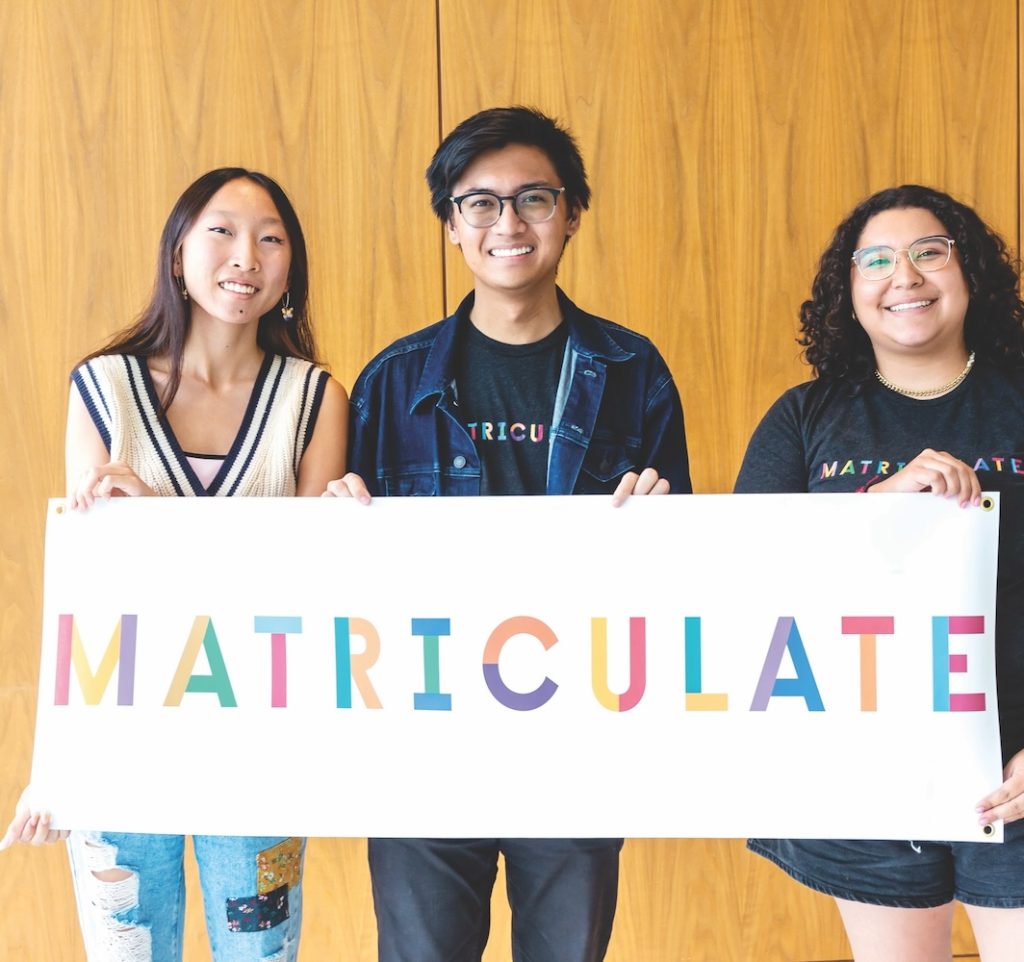Closing the College Knowledge Gap for High School Students
Imagine a high school student in the 90th percentile or higher of their class who is enthusiastic about learning and has a desire to pursue higher education but doesn’t have the resources or information to make their dreams a reality. Studies show that half of high-achieving, low-income students don’t apply to a single college or university that is an academic match. Welcome to the concept of “undermatching.” It can be life-changing for tens of thousands of students.

“Undermatching,” says Bryden Sweeney-Taylor, CEO and co-founder of Matriculate, “is when high school students who are more than qualified to be at top tier universities, are simply not applying or enrolling. They don’t even know where to begin.”
What factors might turn a high-achieving university candidate away from even applying? “A fair amount of students we serve are first-generation college goers,” Sweeney-Taylor says. “So it could be that they’re not in family units or communities where adults who have gone through this can help with the process. So, their resources are just limited. There is also an element of coming from a low-income community and just culturally discounting yourself from certain opportunities for which you’re qualified.”
Matriculate – a national nonprofit – is solving the undermatching problem by connecting high-achieving, high school juniors and seniors from marginalized communities to highly-trained undergraduate advisors called Advising Fellows, who are themselves college students at top colleges and universities. These near-peer advisors provide personalized support to up to four high school students about the college selection, application, and enrollment process.
Near-peer advising is done virtually via text, video chat, and document sharing. “Technology is enabling that personal touch because our advisors can talk to these students wherever they are,” says Shikha Bhatnagar, Matriculate’s VP of external affairs. “So we’re blending that human element with that technology element. This is key to our model.”
“Technology also allows us to reach students in ‘recruitment deserts.’ Rural students,” Sweeney-Taylor adds, “are also high-achieving, but have far fewer resources than their urban counterparts.”
“Your high schooler might be coming in from a really small community,” says former Advising Fellow Kristen Altman. “And you could be the first person to tell them: ‘Hey – this is possible!’”
Since its inception 10 years ago, Matriculate has served over 17,000 high school students across the country and has collaborated with over 4,000 undergraduate Advising Fellows who have delivered free advising to its High School Fellows (HSFs). California is the second most popular home state for Matriculate HSFs and the most popular home state for Matriculate Advising Fellows.
Matriculate also partners with colleges and universities to support Advising Fellows on their campuses. Key partners include Stanford, Princeton, Notre Dame, and Johns Hopkins. Most of Matriculate’s Advising Fellows in California attend one of Matriculate’s three fellowship campuses in the state: Berkeley, UCLA, or Stanford. Not only do they serve as host sites for their college advisors, but college partners are also deeply involved in recruiting HSFs from underrepresented communities through webinars and resource guides. Matriculate is working with new college partners committed to meeting the full financial need of HSFs who enroll on their campuses.
Unlike so many challenges facing our communities, undermatching is solvable. Through Matriculate’s near-peer advising model, high achieving high school students from underrepresented communities are discovering new pathways to their future.
Matriculate
Donate now!matriculate.org
Vice President, External Affairs: Shikha Bhatnagar
(646) 408-3561
Mission
Matriculate’s mission is to empower high-achieving high school students from low-income backgrounds to make the leap to our nation’s top colleges.
Begin to Build a Relationship
We know you care about where your money goes and how it is used. Connect with this organization’s leadership in order to begin to build this important relationship. Your email will be sent directly to this organization’s director of development and/or Executive Director.
As with many of our most dedicated supporters, my passion for Matriculate’s mission is deeply personal. I understand firsthand the challenges that many of our country’s brightest students face in navigating their way to top colleges. I am truly impressed by Matriculate’s ability to connect with over 3,000 high-achieving high school students each year, and I am proud of our impact. I look forward to expanding our reach, thanks to support from donors like you!
Help Students Reach for Their Highest College Goals
Thanks to the generosity of several key donors across California, donations made through The Giving List will be matched up to $100,000!
•$100 recruits one high school student for our Fellow program
•$500 recruits and trains one college student for our Advising program
•$1,000 covers the full Matriculate experience for one high school student
•$2,500 provides a yearly stipend for low-income college students (Advising Fellows)
•$5,000 supports a Matriculate launch at a new college or university in California
•$10,000 recruits and trains 20 Advisors, supporting 60 high school students
•$15,000 funds the launch of a targeted marketing effort to reach more underrepresented and low-income high school students across California
Key Supporters
Jonathan Ashtor, Esq.
Bank of America
Bloomberg Philanthropies
Jasanna Britton
Citadel
Matthew Cullinan
Emerson Collective
Miecha Forbes
Jed Hart
The Ichigo Foundation
Jack Kent Cooke Foundation
Jenesis Group
Madeline Kerner
Jim Larimore
Charley Moore
Jessica Ogilvie
Kim Collins Parizeau
Lynn Anderson Poole
Arthur Rock
Schusterman Foundation
Dane Skillrud
Gregory P. Spivy
Bryden Sweeney-Taylor
Lauran Tuck
